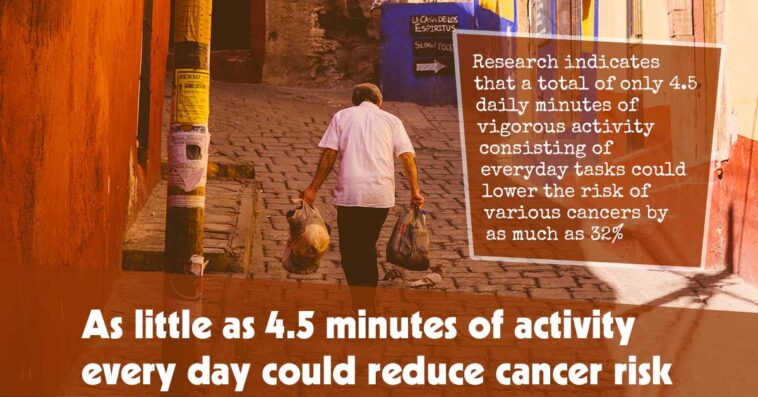Just 4.5 Minutes of Daily Activity May Decrease Cancer Risk
Research indicates that as little as 4.5 minutes a day of vigorous physical activity involving everyday tasks could reduce cancer risks by up to 32%.
This study utilized data collected by wearable devices that monitored daily activity of over 22,000 individuals who did not engage in regular physical exercise and, therefore, were non-exercisers. Researchers then observed their health records over an eight year period for possible signs of cancer development.
Just four to five minutes of VILPA has been associated with significantly decreased cancer risks compared to individuals who did not participate.
Researchers coined the term VILPA (vigorous intermittent lifestyle physical activity) to refer to short, daily bursts of vigorous physical activity lasting one minute each, such as participation in high-energy games with children, power walking bursts or carrying heavy bags of shopping or vigorous housework – similar to applying principles of high intensity interval training (HIIT) into daily life.
Individuals who do not engage in physical exercise face an increased risk of cancers such as colon, endometrial, or breast. Unfortunately, until recently it wasn’t possible to assess the impact of types of intense physical activity that weren’t structured in such ways as vigorous physical activity.
We know most middle-aged individuals don’t engage in regular physical activity, increasing their risk of cancer. Wearable technology innovation such as activity trackers makes it possible to assess short bursts of physical activity as part of everyday living and evaluate its effect.
It is encouraging to see that increasing daily task intensity for just 4 to 5 minutes a day, in short bursts of 1 minute each, can reduce cancer risks by as much as 18% overall and up to 32% when linked to physical activity.
This observational study does not directly investigate cause and effect, but its researchers do note a strong association. They refer to prior early-stage studies showing intermittent vigorous physical activity results in rapid cardiorespiratory fitness improvements, providing potential physiological explanations for reduced cancer risks.
Other potential contributing factors could include physical activity’s role in decreasing chronic inflammation and increasing insulin sensitivity.
More studies need to be completed on this connection, but VILPA could serve as an affordable and appealing approach to cancer risk reduction for individuals who find traditional exercise regimens unappealing or challenging.
Research findings involving 22,398 participants aged on average 62 years who did not engage in leisure time physical activity was as follows:
Studies over an average follow-up period of 6.7 years found 2356 new cancer events, 1084 related to physical activity. At least three minutes of VILPA daily was linked with up to an 18% reduction in cancer incidence compared to no VILPA daily participation.
VILPA was found to reduce cancer related physical activity incidence by up to 32%.
Studies conducted on people performing small amounts of VILPA regularly were found to reduce cancer risks more effectively than non-performers; benefits persisted with increasing levels of VILPA each day, especially for cancers related to physical activity.
VILPA (92%) consisted of bouts as short as one minute.
This study explored the impact of VILPA on overall cancer incidence as well as 13 cancer sites related to physical activity: such as cancer of the esophagus, breast cancer, bladder cancer, neck and head cancer, colorectal cancer, myeloma myeloid leukemia endometrial cancer gastric cardia cancer kidney lung liver.
Data from the UK Biobank Accelerometry Sub Study were utilized, only including individuals who self-identified as non-exercisers; that is, not engaging in leisure time exercises or regular recreational walks.
Individuals that could distort results were excluded, such as those with prior cancer diagnoses or within one year of enrolling in the study. Other influences such as hereditary cancer risk, diet, sleep quality, age, cardiovascular disease risk factors and smoking status were taken into consideration as well.
VILPA was assessed according to participants’ activity levels as measured by accelerometers worn on wrists for seven consecutive days at the beginning of the study, which aligned with other wearable device studies since adult physical activity levels typically remain fairly constant throughout life.
As part of its efforts, cancer registries recorded new cancer events, deaths or hospitalizations due to cancer and deaths or hospitalizations due to cancer.
